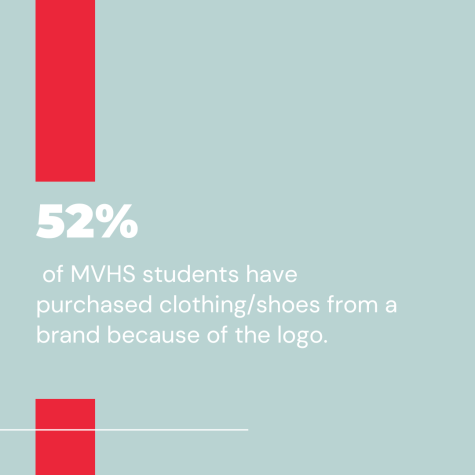Why are consumers fixated on apparel logos?
Observing the effects of brand culture on MVHS students
October 9, 2022
Business teacher Lenore Espanola, a self-proclaimed fashion enthusiast, says she looks out for changing trends among what students are wearing.
“Right now I see girls wearing a combination of an oversized look and a really tight-fitting look,” Espanola said. “[As for male students], I think it’s more casual, more like athletic wear. Maybe jeans and in terms of shoes, primarily sneakers for both men and women. That’s probably more the fashion statement.”
Espanola believes the common ground for these seemingly different outfits is that the choice of clothing can be attributed to brand culture. According to Espanola, “brand culture” is when people are somewhat “emotionally attached to a particular brand or company, feeling like part of the process, part of that brand, but at the same time, focusing on [their] own identity.”
One reason students buy branded clothing is the “safety” factor, according to sophomore Kanchan Kaushik, who says the familiarity of her favorite brands provide comfort.

“I feel like if you’re sticking to one [brand/product], if you really like it, then that’s great,” Kaushik said.
Senior Lance Fuchia agrees, saying that since shoppers stick to the brands that suit them best, they might shy away from looking for new brands or companies — According to Fuchia, diversifying where he buys his clothes from is “not a [top] priority”.
Staying comfortable with their select few brands, Kaushik and Fuchia both have a list of the top brands they shop from, with Fuchia’s list containing H&M, Nike, Old Navy and Adidas, while Kaushik prefers Brandy Melville, Urban Outfitters, Hollister, Pacsun and Forever 21.
Many of these brands sell viral products commonly worn by MVHS students such as the Nike Air Force 1’s or Urban Outfitter’s “Out From Modern Love” corset according to Fuchia and Kaushik. The basic and clean look that these products offer appeal to Fuchia and Kaushik due to their versatility. Espanola states how, as more consumers are seen with these viral products, others are allured into wanting these products as well. Espanola also believes these companies capitalize off the “popularity factor” and uniqueness of these products to increase sales.
“If you’re targeting a particular group, like young people or teenagers, for a fashion brand, I think [social media advertising] would probably be successful,” Espanola said. “Especially if they’re using the right media.”
Espanola also describes how social media is a common way to stay up to date with fashion trends, and Fuchia agrees with this, saying he uses TikTok and Instagram to determine parts of his clothing style by looking at others for inspiration.

“Current fashion has really gone viral over the past one [or two] years, and I’ve been influenced by what I’ve seen on social media,” Fuchia said. “That’s why I purchased cargo pants and Air Force Ones.”
A common consequence of brand culture is the creation of “fakes,” clothing or shoes meant to plagiarize parts or the entirety of a piece from certain brands with the goal being that consumers will purchase the product at a cheaper price. Some believe fakes aren’t necessarily a bad thing.
“Well, I think if you know the quality of [the fake] and you think it’s the same, I think that it’s definitely worth it,” Kaushik said.
Students may feel social pressure to purchase and wear fakes because they provide a feeling of buying into the brand on a budget, a pattern Fuchia has noticed and Espanola comments on. Buying into the brand includes buying the logo and Espanola states how some brands often use their logo as a vibrant centerpiece to the article of clothing to attract attention.
“Of course young women are probably going to go for the Lululemon because it has the logo,” Espanola said. “For me I [would pay] for [leggings] if [they] fit better.”

Fuchia agrees with Espanola and says that he has seen this pattern too, particularly in footwear.
“I think in terms of shoes, businesses are a lot better at marketing because on every shoe, you can tell what brand it’s from because the brand logo [is] literally on the shoe,” Fuchia said. “Once you see a shoe, you know immediately which brand produced it.”
Despite the influence of brand culture, Espanola, Fuchia and Kaushik believe that developing a personal style differs for each person and the satisfaction obtained from a purchase triumphs over other factors. According to Espanola, this could mean buying clothes at a certain price range or purchasing clothes that provide significant memories, such as her handbag from Spain.
“As an adult, I work hard,” Espanola said. “I did buy a handbag, like a little wallet, because it’s far and I’m only going to get it [in Spain] right? And if you [feel] good, right, it’s OK.”



















